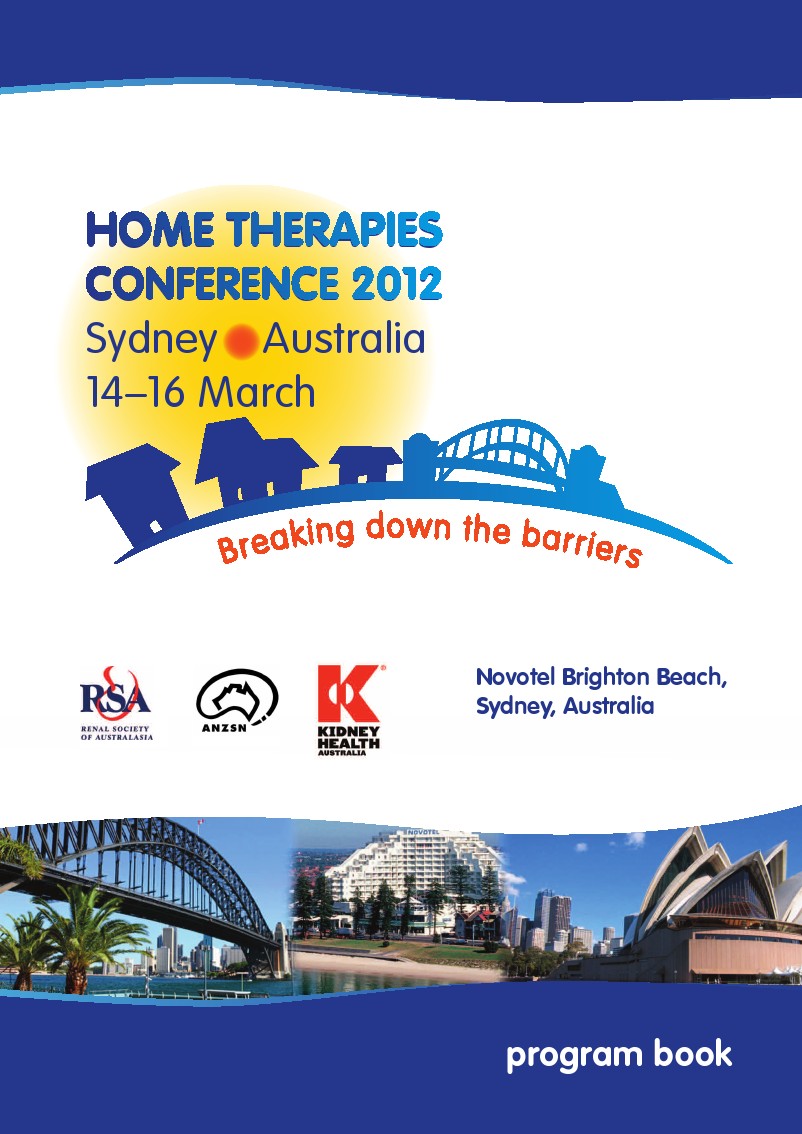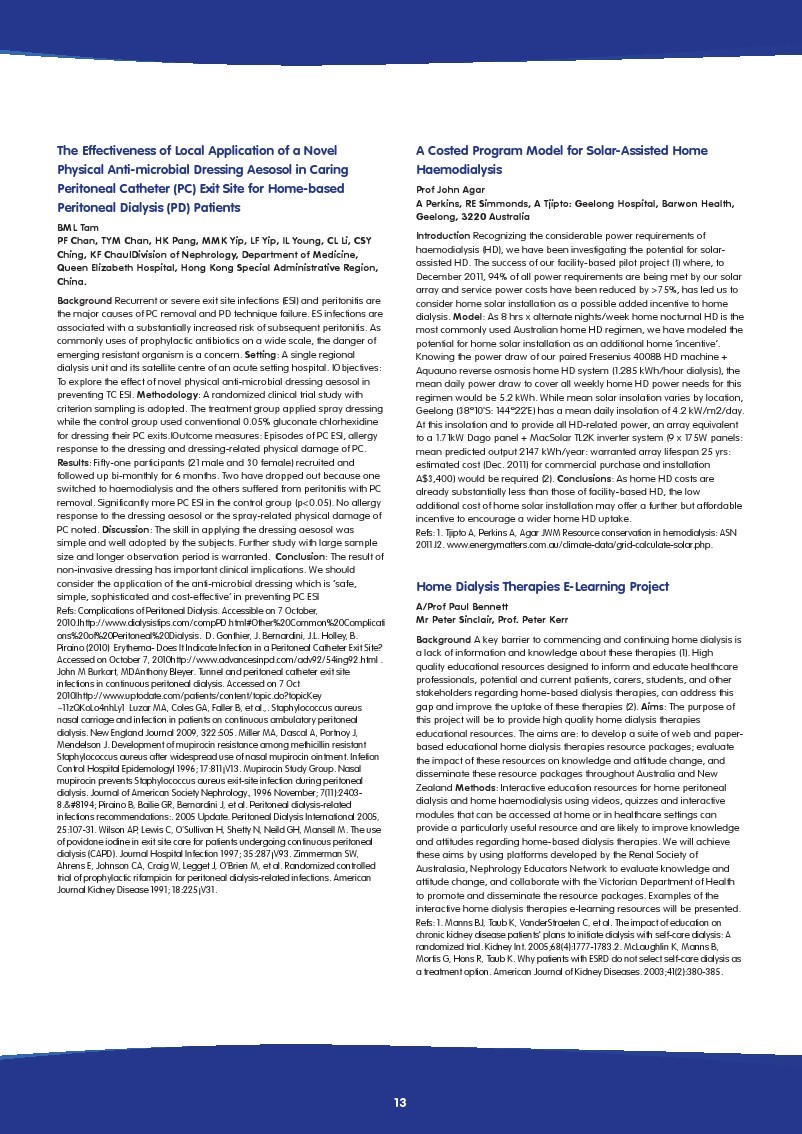PF Chan, TYM Chan, HK Pang, MMK Yip, LF Yip, IL Young, CL Li, CSY Ching, KF Chau|Division of Nephrology, Department of Medicine, Queen Elizabeth Hospital, Hong Kong Special Administrative Region, China.
Background Recurrent or severe exit site infections (ESI) and peritonitis are the major causes of PC removal and PD technique failure. ES infections are associated with a substantially increased risk of subsequent peritonitis. As commonly uses of prophylactic antibiotics on a wide scale, the danger of emerging resistant organism is a concern. Setting: A single regional dialysis unit and its satellite centre of an acute setting hospital. |Objectives: To explore the effect of novel physical anti-microbial dressing aesosol in preventing TC ESI. Methodology: A randomized clinical trial study with criterion sampling is adopted. The treatment group applied spray dressing while the control group used conventional 0.05% gluconate chlorhexidine for dressing their PC exits.|Outcome measures: Episodes of PC ESI, allergy response to the dressing and dressing-related physical damage of PC. Results: Fifty-one participants (21 male and 30 female) recruited and followed up bi-monthly for 6 months. Two have dropped out because one switched to haemodialysis and the others suffered from peritonitis with PC removal. Significantly more PC ESI in the control group (p<0.05). No allergy response to the dressing aesosol or the spray-related physical damage of PC noted. Discussion: The skill in applying the dressing aesosol was simple and well adopted by the subjects. Further study with large sample size and longer observation period is warranted. Conclusion: The result of non-invasive dressing has important clinical implications. We should consider the application of the anti-microbial dressing which is ‘safe, simple, sophisticated and cost-effective’ in preventing PC ESI
Refs: Complications of Peritoneal Dialysis. Accessible on 7 October, 2010.|http://www.dialysistips.com/compPD.html#Other%20Common%20Complicati ons%20of%20Peritoneal%20Dialysis. D. Gonthier, J. Bernardini, J.L. Holley, B. Piraino (2010) Erythema- Does It Indicate Infection in a Peritoneal Catheter Exit Site? Accessed on October 7, 2010http://www.advancesinpd.com/adv92/54ing92.html . John M Burkart, MDAnthony Bleyer. Tunnel and peritoneal catheter exit site infections in continuous peritoneal dialysis. Accessed on 7 Oct 2010|http://www.uptodate.com/patients/content/topic.do?topicKey
~11zQKoLo4nhLy1 Luzar MA, Coles GA, Faller B, et al.,. Staphylococcus aureus nasal carriage and infection in patients on continuous ambulatory peritoneal dialysis. New England Journal 2009, 322:505. Miller MA, Dascal A, Portnoy J, Mendelson J. Development of mupirocin resistance among methicillin resistant Staphylococcus aureus after widespread use of nasal mupirocin ointment. Infetion Control Hospital Epidemologyl 1996; 17:811¡V13. Mupirocin Study Group. Nasal mupirocin prevents Staphylococcus aureus exit-site infection during peritoneal dialysis. Journal of American Society Nephrology., 1996 November; 7(11):2403- 8. Piraino B, Bailie GR, Bernardini J, et al. Peritoneal dialysis-related infections recommendations:. 2005 Update. Peritoneal Dialysis International 2005, 25:107-31. Wilson AP, Lewis C, O’Sullivan H, Shetty N, Neild GH, Mansell M. The use of povidone iodine in exit site care for patients undergoing continuous peritoneal dialysis (CAPD). Journal Hospital Infection 1997; 35:287¡V93. Zimmerman SW, Ahrens E, Johnson CA, Craig W, Legget J, O’Brien M, et al. Randomized controlled trial of prophylactic rifampicin for peritoneal dialysis-related infections. American Journal Kidney Disease 1991; 18:225¡V31.
A Perkins, RE Simmonds, A Tjipto: Geelong Hospital, Barwon Health, Geelong, 3220 Australia
Introduction Recognizing the considerable power requirements of haemodialysis (HD), we have been investigating the potential for solar- assisted HD. The success of our facility-based pilot project (1) where, to December 2011, 94% of all power requirements are being met by our solar array and service power costs have been reduced by >75%, has led us to consider home solar installation as a possible added incentive to home dialysis. Model: As 8 hrs x alternate nights/week home nocturnal HD is the most commonly used Australian home HD regimen, we have modeled the potential for home solar installation as an additional home ‘incentive’.
Knowing the power draw of our paired Fresenius 4008B HD machine + Aquauno reverse osmosis home HD system (1.285 kWh/hour dialysis), the mean daily power draw to cover all weekly home HD power needs for this regimen would be 5.2 kWh. While mean solar insolation varies by location, Geelong (38°10'S: 144°22'E) has a mean daily insolation of 4.2 kW/m2/day. At this insolation and to provide all HD-related power, an array equivalent to a 1.71kW Dago panel + MacSolar TL2K inverter system (9 x 175W panels: mean predicted output 2147 kWh/year: warranted array lifespan 25 yrs: estimated cost (Dec. 2011) for commercial purchase and installation A$3,400) would be required (2). Conclusions: As home HD costs are already substantially less than those of facility-based HD, the low additional cost of home solar installation may offer a further but affordable incentive to encourage a wider home HD uptake.
Refs: 1. Tjipto A, Perkins A, Agar JWM Resource conservation in hemodialysis: ASN 2011.|2. www.energymatters.com.au/climate-data/grid-calculate-solar.php.
Home Dialysis Therapies E-Learning Project
Mr Peter Sinclair, Prof. Peter Kerr
Background A key barrier to commencing and continuing home dialysis is a lack of information and knowledge about these therapies (1). High quality educational resources designed to inform and educate healthcare professionals, potential and current patients, carers, students, and other stakeholders regarding home-based dialysis therapies, can address this gap and improve the uptake of these therapies (2). Aims: The purpose of this project will be to provide high quality home dialysis therapies educational resources. The aims are: to develop a suite of web and paper- based educational home dialysis therapies resource packages; evaluate the impact of these resources on knowledge and attitude change, and disseminate these resource packages throughout Australia and New Zealand Methods: Interactive education resources for home peritoneal dialysis and home haemodialysis using videos, quizzes and interactive modules that can be accessed at home or in healthcare settings can provide a particularly useful resource and are likely to improve knowledge and attitudes regarding home-based dialysis therapies. We will achieve these aims by using platforms developed by the Renal Society of Australasia, Nephrology Educators Network to evaluate knowledge and attitude change, and collaborate with the Victorian Department of Health to promote and disseminate the resource packages. Examples of the interactive home dialysis therapies e-learning resources will be presented.
Refs: 1. Manns BJ, Taub K, VanderStraeten C, et al. The impact of education on chronic kidney disease patients' plans to initiate dialysis with self-care dialysis: A randomized trial. Kidney Int. 2005;68(4):1777-1783.2. McLaughlin K, Manns B, Mortis G, Hons R, Taub K. Why patients with ESRD do not select self-care dialysis as a treatment option. American Journal of Kidney Diseases. 2003;41(2):380-385.


![]() The Effectiveness of Local Application of a Novel澳大利亚会刊.pdf
The Effectiveness of Local Application of a Novel澳大利亚会刊.pdf
© 2020 南京神奇科技开发有限公司 版权所有 洁悠神学术中心